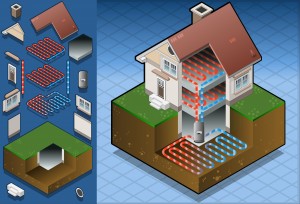Many people have heard of geothermal comfort systems, but fewer people could explain in much detail how they actually work. Having a deeper understanding of how efficiently these systems work can help you determine if this technology is right for your home.
Read on to discover how geothermal technology harnesses the power of the Earth to provide clean, renewable, and reliable energy.
What is Geothermal Heating and Cooling Technology?
When most people consider the different energy sources available for heating and cooling a home, it’s likely they only know about these options: natural gas, electricity, oil, and solar. Although these are by far the most commonly used methods, geothermal technology has become increasingly popular.
Geothermal comfort systems rely on the constant temperature of the Earth’s crust to regulate the temperature of your home. They operate like a heat pump but instead of using air, they use thermal energy from underground to regulate the temperature of the air they provide.
Perhaps you’ve wondered how a geothermal heat pump cools your home when it’s hot outside and vice versa. People mistakenly assume that when temperatures go up or down, the temperature of the ground beneath us also fluctuates. This isn’t true.
Just a few feet beneath the ground, the temperature is consistent regardless of the ambient air temperatures and ranges between 45°F and 55°F. At a depth of 15–30 feet, the underground temperature is a steady 55°F.
How It Works
Geothermal systems operate differently when they’re in heating mode vs. cooling mode. In the summer, the system removes heat from your home and disperses it into the ground. In the winter, it brings the heat from the ground and disperses it into your home. Let’s take a closer look at how they operate.
Heating Mode
- Circulation: The heat pump moves water or refrigerant through pipes or ground loops that are buried underground
- Heat Absorption: The fluid absorbs heat from the ground.
- Heat Exchange: The heated fluid returns to the home and transfers heat through a heat exchanger.
- Recirculation: The fluid returns to the ground loop to be heated again.
Cooling Mode
- Heat Exchange/Absorption: Water or refrigerant absorbs heat from the ambient air via a heat exchanger, similar to how a traditional air conditioner works.
- Circulation: The heat pump moves the heated fluid through the underground pipes or ground loops.
- Heat Discharge: The heated fluid gives off heat as it passes through the ground loop.
- Recirculation: The fluid returns to the building and absorbs heat again
The Main Type of Geothermal Systems
The key type of geothermal system that is installed for most homes is the closed-loop system. A close-looped system can be set up in a vertical or horizontal arrangement. It consists of a series of underground pipes filled with a fluid that transfers geothermal energy to the heat pump. The vertical arrangement is most common as it requires less outdoor space.
If you’ve ever wondered whether your home is a good candidate for a geothermal heating and cooling system, call Fulmer Heating and Cooling today to schedule an appointment with one of our geothermal HVAC experts. Proudly serving homes throughout Columbia for over 30 years.

